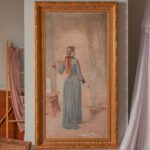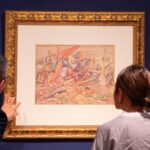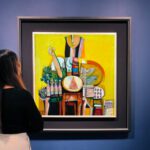As more of us are looking to brighten and enrich our homes and creative spaces, we find ourselves turning to art. While most of us may not have access to hanging big ticket paintings on our walls, we do have an enormous selection of print collectibles open for our perusal. But this begs the question: what is a print collectible?
Printmaking itself is an ancient artform that dates back to 9th century China (in the case of woodblock prints). Intaglio techniques like engraving, etching, and aquatint were developed in the Renaissance and lithography began during the industrial age. Over time, new technology allowed for new techniques and by the 20th century, prints were perceived in a new light: as a way to multiply artists’ output at more accessible price points (‘Collectible Prints’ from collectorsweekly.com) Though produced in larger quantities, these prints remain collectible because of the finite number in which they were produced either by the artist himself or with his authorization.
Internationally, print collectibles have made a big splash in the art market, with print works by artists like Pablo Picasso, Marc Chagall, Andy Warhol, and Keith Haring selling for hundreds–if not thousands-of dollars.
Local artists have also taken to expanding their body of work to include print collectibles. Print editions by established artists like Anita Magsasay-Ho, Fernando Zobel, Alfonso Ossorio, BenCab, and Lee Aguinaldo to name a few, are offered both by museums and auction houses.
But what exactly are the different types of print collectibles, and do these different types have any bearing on a piece’s value?
What’s in a name? A quick guide to the different types of print collectibles
The sheer variety and complexity of different printmaking techniques is such that even long-time print collectors find themselves refreshing their memories on the terminology! After all, just as there are a rich spectrum of art styles and techniques, so are there for making print collectibles. In recent years, this category of collectibles has also expanded to include art toys, limited edition calendars, and posters to name a few. In this post, we’ll be dealing with examples you can find in the upcoming #interiors online auction on July 25, from 11am onwards.
Offset lithograph and/or Posters– a type of lithograph print made using an offset press. Instead of transferring ink by hand, an offset press is used to transfer ink to a rubber blanket and then to directly apply it to either stone or paper. This technique has grown immensely popular in recent years due to its affordability, quality, and speed of production (“What is a Lithograph? Understanding Different Types of Printing” from invaluable.com) Offset lithography is actually the most popular technique used to create posters. In fact, in the 1960s, it was the preferred medium used to create the famous limited-edition San Francisco rock posters.
Digital print – a print created with a computer using highly saturated, pigment-based archival inks on paper, canvas, or vinyl. Large-scale inkjet printers emit a fine mist of tiny ink droplets onto the surface in order to produce a uniformly toned image. It is considered an original print if it was intended as a unique artwork. If not, then the digital print is considered a reproduction of the original work in a different medium (“Digital Print” from artsy.net.)
Art toys – are produced either directly by the artists or his/her estate, or are produced by bodies that have secured the artist or his/her authorization to produce them. Famous examples are the Yayoi Kusama resin pumpkins offered at the MET design store, the highly popular MEDICOM x Estate of Jean Michel-Basquiat Bea@rbrick figures, as well as the instagrammable Takashi Murakami Flower pillows and art toys.
Postcards and/or calendars – These are authorized reproductions of artworks or images. Either the artist or his/her estate authorizes the reproduction of his/her artworks which are then offered as accessible collectibles to the general public. Famous examples of this are postcard sets, and even posters that you can find in museum shops. Because these are produced in limited quantities, they are considered collectibles and can even gain value over the years.
Variety and complexity of printmaking techniques aside, the common thread that ties them all together is the fact that these are works created either directly or indirectly by an artist or his/her estate, or by an institution that has secured the artist or estate’s authorization. Their limited production number also lends to high collectibility of these works
Finally, how do these collectibles reach collectors like us?
#artforall: The democratization of art through editioned multiples
After exploring the different types of print collectibles and authorized art editions, we come at last to the most exciting question of all: how then, do we come by these pieces and include them in our collections and homes?
We have the artists and art institutions to thank for making these artworks and collectibles available to the general public. Over the years, the art of printmaking has transformed from guild-based craftsmanship to adventurous and experimental art medium. The bodies of work of artists like Andy Warhol and Roy Lichtenstein have become almost synonymous with their chosen print mediums (screen printing for Warhol and a mix of mechanical reproduction and hand drawing for Lichtenstein) because for them, the process is just as much a part of their art as the finished product. And so artists have either taken up the print medium or worked with art institutions to make their work accessible to collectors and art enthusiasts alike.
Today, many of us are able to enjoy our favorite artists’ works through the authorized prints or digital reproductions of their pieces. Be it a poster, postcard, calendar, art toy, or even a collaboration with another brand (think Takashi Murakami x Louis Vuitton), it’s a sign of how the art market continues to grow and adapt to these ever-changing times.
The main takeaway? Art is there for all to appreciate and enjoy, whether it’s in the form of a work on canvas or paper, or a fine art print or authorized digital reproduction– the medium may be different, but the joy derived from seeing and collecting it just the same!
So we encourage collectors and art enthusiasts to patronize pop-ups, museum stores, etc. for these authorized printed collectibles. As our auctions have shown, today’s souvenir could be tomorrow’s treasure!
Discover your own new treasure at the upcoming Gavel&Block ‘interiors’ online auction this coming 25 July, 2020 11am PHT onwards. View the online catalogue at Gavel&Block ‘interiors’ online catalogue













